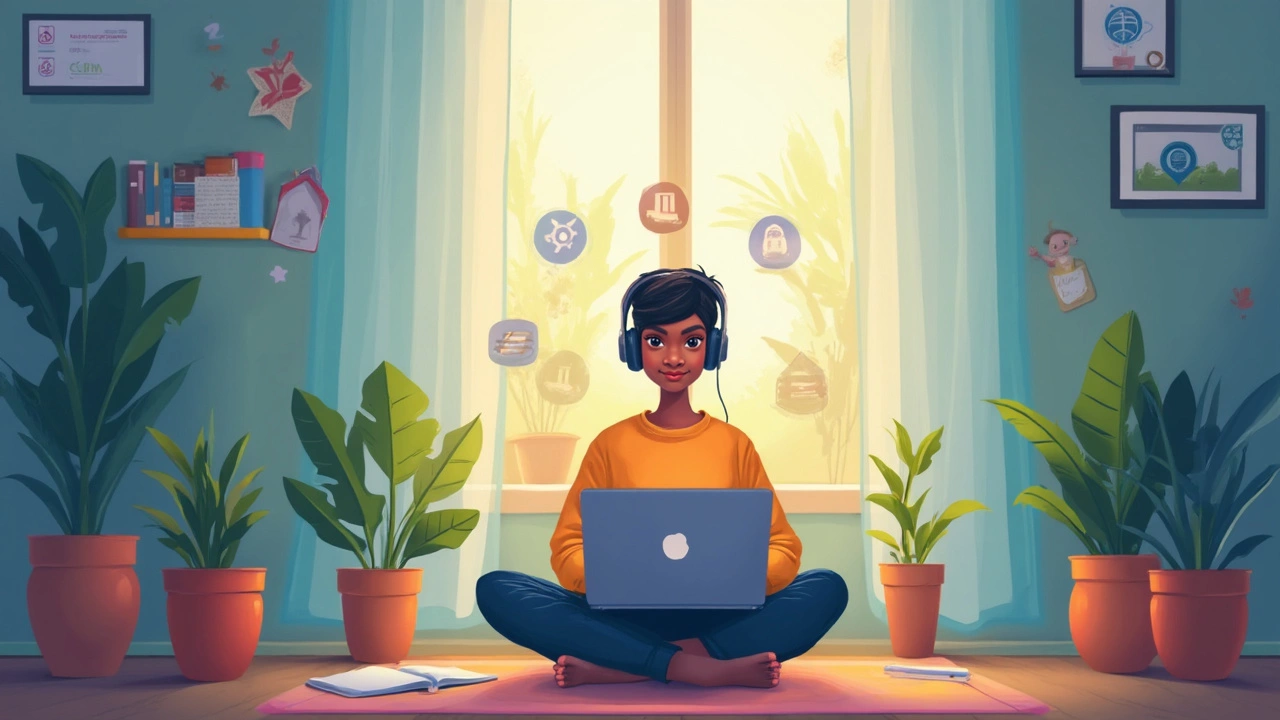So, you're curious about what makes classroom learning different from eLearning, huh? Well, you're not alone. As education moves deeper into the digital age, more folks are weighing the pros and cons of each method. Understanding their differences can really help in figuring out what suits your learning style the best.
First up, think about the environment. A traditional classroom is pretty much about desks, a chalkboard, and someone standing at the front teaching you in real-time. eLearning, on the other hand, flips the script. It can happen anywhere, anytime, as long as you've got an internet connection. This means you can be in your PJs in bed while attending a virtual lecture—not a bad deal, right?
But it's not just about where you learn. Flexibility plays a big part, too. In a classroom, schedules tend to be set in stone. Miss a lesson, and you might find yourself struggling to catch up. With eLearning, there's often more wiggle room. You can hit pause or rewind on recorded lessons until the concept finally clicks. For folks juggling jobs or kids, or just about anyone who despises early mornings, this can be a game-changer.
- Learning Environments
- Flexibility and Accessibility
- Interaction and Engagement
- Customization and Personalization
- Assessment and Feedback
- Cost and Resources
Learning Environments
Alright, let's break it down. The learning environments for classroom settings and eLearning are worlds apart, and each brings its own vibe to the table. Picture a typical classroom: it's a physical space where students gather, with a front row for eager beavers and back rows for the more laid-back learners. This setup allows for in-person communication and spontaneous discussions. Having classmates around can spark immediate thoughts and ideas, making learning feel more like a shared journey.
Flip the script with eLearning, and you've got a setup that's as DIY as it gets. You can study in cafes, at the park, or from your own cozy corner at home. The beauty here is having the world as your classroom—literally. This flexibility is a major perk, especially here in New Zealand, where remote charm offers so many stunning backdrops for a virtual classroom.
Of course, both environments have their quirks. Traditional classrooms typically stick to a tight schedule, which works for habitual planners but might be a nightmare for someone who loves a bit of wiggle room. And let's not forget that a classroom can be distracting, with fidgeting classmates and unexpected fire drills throwing off your focus.
In contrast, eLearning platforms let you dive into materials at your own pace, pausing when you need a snack or just need to take a breath. But, it can also mean battling tech hiccups now and then. Your WiFi drops, or your laptop decides it needs a nap—technology isn't always a smooth ride.
| Classroom Learning | eLearning |
|---|---|
| Fixed schedule | Flexible timing |
| Physical interaction | Virtual interaction |
| Commute required | Study from anywhere |
At the end of the day, choosing the right environment boils down to what fits your style. Need a steady routine? Classroom learning might be your best bet. Crave flexibility and a bit of travel-inspired study sessions? eLearning could be calling your name.
Flexibility and Accessibility
Dive into the world of eLearning, and you'll quickly notice how flexible it can be. You’re not tied to a classroom or a timetable, which means you can fit learning around your life, not the other way around. This is a big draw for busy folks—it’s a game-changer for those with jobs, family duties, or just a hectic life in general.
This flexibility doesn’t just stop at scheduling. eLearning platforms open up access to an ocean of resources. Got an internet connection? Great, you can learn. Whether you’re in a bustling city or out in the sticks, it's all just a click away. This kind of access wasn't possible in the old-school classroom setting.
"Online learning is not the next big thing, it is the now big thing." — Donna J. Abernathy
While some might miss the face-to-face interaction of a classroom, eLearning shines when it comes to providing a treasure trove of information. From video lectures to downloadable notes and interactive quizzes, you've got all the tools you need at your fingertips.
| Method | Flexibility | Accessibility |
|---|---|---|
| Classroom Learning | Rigid schedules | Limited to location |
| eLearning | Fits personal schedules | Accessible anywhere with internet |
This shift has been huge. Many people no longer see education as something confined to a classroom with a 9-to-3 schedule. Instead, it’s a more personal journey where you’re in the driver’s seat. If you’re the type to roll out of bed and study in pajamas, eLearning could be your perfect match.
Interaction and Engagement
When it comes to interaction and engagement, traditional classroom learning and eLearning have distinct vibes. In a classroom setting, there's this immediate energy you get from being surrounded by other students. You can raise your hand, share a quick thought, or even bust out into a heated debate about the day's topic. The interaction is instant and often leads to some memorable educational experiences.
eLearning, though, takes a different approach to keeping students engaged. Instead of live interactions, most digital platforms have forums or chat features. You won't get that face-to-face feedback, but you can join in discussions with classmates from miles away or even from other parts of the world. Some platforms integrate video conferencing to add a more personal touch, trying hard to bridge that gap between screen and reality.
Interactive elements like quizzes, polls, and even gamified learning experiences are more common online. Platforms often use these tools to break the monotony and keep learners on their toes. Also, lots of eLearning courses use analytics. They track your progress and recommend sessions based on your performance, showcasing what the digital space can offer that the traditional setup can't quite match.
But there's a catch—eLearning can sometimes feel a bit isolating. If you're someone who thrives on personal interaction, finding your mojo in an online setting can be trickier. Platforms have started introducing collaborative projects and virtual study groups to combat this, but it's something to keep in mind if you're considering making the switch.
Interestingly, a study in 2023 found that courses with high interaction levels see about a 30% improvement in student performance. The more chances learners get to engage, whether face-to-face or digitally, the better they tend to grasp and retain the material.

Customization and Personalization
Here's the thing—one size doesn't fit all when it comes to learning. Everyone's got their own pace and style, right? That's where the magic of eLearning really shines, all thanks to its knack for customization and personalization.
Think about what you can do with digital platforms. They allow learners to choose what topics to dive into and how deep they want to go. Not in the mood for that algebra lecture today? No worries! Switch to something else and come back when your brain's ready for numbers.
These platforms also often come with nifty features like adaptive learning technologies. Ever heard of them? They’re smart systems that adjust the level of difficulty based on student performance. So if you're breezing through topics, your lessons get harder to keep you challenged. Struggling a bit? It circles back to the fundamentals to make sure you’ve got a solid understanding.
- Progress Tracking: Keeping tabs on how you're doing is a breeze with eLearning. Apps and platforms often have dashboards where you can see your stats, like quiz scores or the time you've spent on each lesson.
- Personalized Content Recommendations: Just like Netflix suggests movies based on what you’ve watched, eLearning platforms offer suggestions for lessons you might find interesting or beneficial.
Now, not to say classroom learning doesn’t have its comforts, but tailoring lessons to individual needs with such precision isn't its strongest suit. Classroom setups tend to follow a set curriculum where everyone plows through the same syllabus at the same pace, which might not be perfect for everyone.
Plus, some platforms even let students pick the teaching style they prefer, whether it's video lectures, text-based modules, or interactive tasks. This kind of freedom isn't just cool—it can massively up your engagement and retention levels. Who knew learning could be such a personalized journey?
Assessment and Feedback
Alright, let’s talk about assessment and feedback. This is a biggie when comparing classroom learning and eLearning. In a traditional classroom, assessments often come in the form of quizzes, tests, or assignments handed back with comments scribbled in red ink. Teachers generally provide feedback face-to-face, allowing for immediate clarification on questions or misunderstandings.
Now, how does this stack up against eLearning? Well, the digital world gives assessments a whole new twist. Online courses often use multiple-choice quizzes with instant results. Some platforms even have the smarts to suggest resources based on your answers! Talk about high-tech personalization.
Feedback in eLearning is often ongoing and interactive. Online forums, emails, and chat functions allow students to reach out anytime they need help. Courses equipped with AI might even offer automated feedback based on your responses. Many students find this kind of real-time interaction actually enhances the learning experience.
Another cool thing about eLearning is that it can provide detailed analytics. Platforms can track how long you spend on each task, where you struggle, and where you ace it—helpful for getting a full picture of what you need to focus on. Some reports even suggest that digital feedback can increase student engagement by 30% or more.
Let's not forget the flexibility of retaking assessments. In many eLearning setups, you get numerous attempts to get things right, learning from each try. It’s a learning-first approach, unlike the one-shot-and-done method often seen in classrooms.
In short, whether it's the in-person nuances of a classroom or the technologically driven feedback of eLearning, the goal remains the same: helping students learn and grow. The method of feedback expects every learner to find their stride in their unique educational journey.
Cost and Resources
When it comes to choosing between classroom learning and eLearning, money often plays a big part. So, what’s the real deal with costs here? Traditional classroom settings can get pricey. You've got tuition fees, and let’s not forget textbooks, commuting, and maybe even uniforms or equipment for certain subjects. All these can stack up pretty quick.
Now, how does eLearning stack up cost-wise? For starters, it's usually more budget-friendly. You don't need to worry about commuting, and textbooks often come as digital versions, either for free or much cheaper. Plus, many online courses offer lower tuition fees since they don’t have to maintain big campuses. If you're a fan of saving money (and who isn't?), online learning might be your jam.
Okay, now let's talk resources. In a classroom, you've got the teacher and whatever stuff is available at school like labs, libraries, or sports gear. Online, the resources are practically endless. Tons of platforms like Coursera and Khan Academy offer courses, covering almost any topic you can think of. You can access free books, videos, and even expert talks that might not be available in a traditional setup.
Here’s a cool thing—some employers offer financial support for online courses. So, while you’re learning, you could also be saving up for that next holiday. Just check if your workplace has any educational incentives.
All those resources at your fingertips? It makes eLearning super versatile. Whether you want to dip your toes into a new subject or dive deep into something specific, the opportunities are huge. Just remember, though, that you'll need a reliable internet connection and maybe a computer that can handle video classes smoothly.
So, when it comes to Cost and Resources, both have their perks, but the digital route might give you more bang for your buck.




